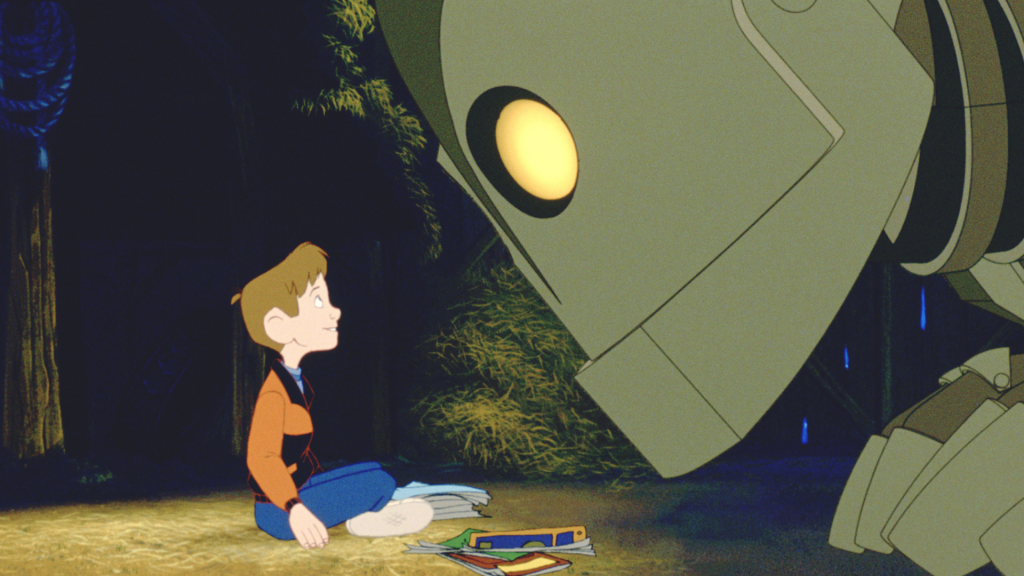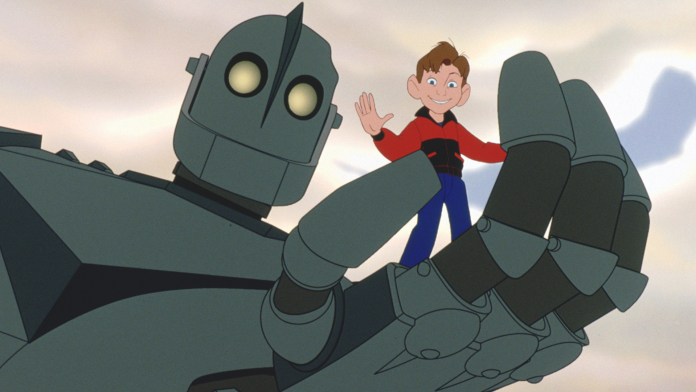Movie Monday: Film Recommendations By Our Contributors
My very first memory of this film is from when I was around eight years old, and it all stemmed from one morning in primary school—The Iron Giant. Our class had a science lesson focused on robots, and it was here that I witnessed something magical. Not only did it kickstart my fascination with robots and science fiction, but this metallic titan would also eventually become one of my all-time favourite characters. As I grew up, I came to realise that The Iron Giant retains a far more poignant and deeper sentiment beyond being a story about a gigantic machine.
Based on the Ted Hughes novel The Iron Man, the film is set in 1957 at the height of the Cold War. The titular colossal alien robot (mechanically voiced by Vin Diesel) crash lands on the coast of the fictional town of Rockwell, Maine. Sooner or later, an imaginative young boy named Hogarth (Eli Marienthal) discovers the giant and subsequently, they become friends. However, he must also try to hide him from a paranoid government agent, Kent Mansley (Christopher McDonald) and his mother Annie (Jennifer Aniston).
The idea of concealing a secret fantastical companion is a familiar one. It has surfaced in family-oriented films in the past, with a prime example being E.T. the Extra-Terrestrial (1982). Nevertheless, The Iron Giant is more than a new spin on the family science fiction genre. An astonishing arrangement of striking animation and intricate thematic implications construct a greater-than-timeless masterpiece that touches upon the nature of war in a turbulent time of political unrest in America.

Within the fantasy or science fiction genres, cinema has been the host many stories about isolated characters stumbling across something extraordinary amidst intense political situations. Pan’s Labyrinth (2006) is a striking example of fantasy and harrowing periodic tension overlapping in one person’s life. A girl follows into an imaginary world to escape the horrors committed by her tyrannical stepfather during the Francoist dictatorship. The Iron Giant features a very similar structure compared to this film, but it approaches this certain story type with its own unique characteristics and techniques.
The film is set in the 1950s, at a time of tight political tension between the USA and what was then the USSR. The underlying but constant threat of nuclear war loomed over public consciousness, and the science fiction genre increased in popularity during this time. This was due to the ongoing Space Race between the two superpowers, coinciding with a cascade of motion pictures with futuristic elements. The inspiration behind this golden age of sci-fi leads to what The Iron Giant is grounded in; the uncertainty of technology and our future. But on the other hand, this film essentially demystifies these doubts, fundamentally proposing a clear anti-war statement.
The Iron Giant himself acts as the most prominent visualisation of the film’s message. Throughout the narrative, he is unable to recall his past life and is compelled to effectively start over and uncover the basics regarding how he became misplaced on Earth. At this point arrives Hogarth, who exhibits a passionately creative personality and is basically alone apart from his widowed mother. Additionally, as a young boy growing up in the 1950’s regularly being subjected to nuclear propaganda and political scares, he requires a form of escapism. Consequently, the two characters develop a friendship, with Hogarth teaching the Iron Giant human interactions and principles.
A strong anti-war message is displayed through their relationship, as it explores the concept of a constructed weapon of destruction rejecting its purpose and encompassing an empathetic soul. Traces of compassion slowly emerge when Hogarth educates the giant about basic ideas, such as the difference between a rock and a tree, to morally complex sentiments like the concept of death after witnessing the killing of a deer. Ultimately, the giant declares “I am not a gun,” thus becoming a symbol of progression, hope and peace.

In stark contrast, Kent Mansley symbolises a more conservative and prejudiced viewpoint. He openly despises the giant and even rents a room Hogarth’s house solely to hunt him down. Kent is the exact polar opposite of what the giant eventually grows into, hence creating this hostile rivalry with differing values. His openly xenophobic views, propensity towards violence, and extreme suspicion of anything uncommon further heightens the film’s peaceful undertones by serving as an allegory of political distrust during this period.
Portrayals of war and peace create the heart and soul of The Iron Giant, but the animation is the glue that holds these elements together. Everyone and everything from backdrops to different atmospheres are all animated through traditional 2D artwork, with one notable exception—the giant himself. He is brought to life through CGI and blends seamlessly with the rest of the hand-drawn environments, yet at the same time standing out as an outsider in a strange new world. This is how The Iron Giant succeeds in every department, because without innovative or artistically charged animation, its anti-war dialogue would b eneither as powerful or as everlasting. A combination of 2D and 3D animation reinforces the progressive ideal this film carries, by combining both an older and newer form of animation to demonstrate technological advancement and, it is implied, hope for a more advanced and peaceful future.
The Iron Giant is not merely a standard family film. I believe it is a story that echoes far beyond your initial expectations. It is a true sadness that the film was a financial failure at the time of its original 1999 release. Thankfully, a cult following has spared it the fate of obscurity and in the years since The Iron Giant has received the praise it more than thoroughly deserves. Bird’s film warrants viewing from any demographic since it showcases numerous qualities which younger to older ages can appreciate and savour. Above all, The Iron Giant teaches us that it is never exclusively appearance that defines us. It is what your soul guides you to accomplish that identifies who you are. As Hogarth says to the Iron Giant, “you are who you choose to be.”
Words by Ethan Soffe
Support The Indiependent
We’re trying to raise £200 a month to help cover our operational costs. This includes our ‘Writer of the Month’ awards, where we recognise the amazing work produced by our contributor team. If you’ve enjoyed reading our site, we’d really appreciate it if you could donate to The Indiependent. Whether you can give £1 or £10, you’d be making a huge difference to our small team.
